Having read the theory behind the pentatonic scales, you should already be familiar with the basic intervals and use of the major and minor pentatonic scale.
It is now time to learn how to use the minor pentatonic scale, which is a must if you want to learn to play lead guitar and improvise.
This practical guide to using the minor pentatonic scale will be of true benefit to you once you are familiar with your basic lead guitar techniques. You will now learn to use the scale all over the fretboard, but keep in mind that playing the notes 1 by 1 will not sound good in itself. You really need to apply vibrato to your notes, skip strings, slide between notes, and so on.
So, without further ado, let's begin learning about how to use the minor pentatonic scale.
The reason many great guitarists in various genres use the minor pentatonic scale is due to the fact that even though it is simple, it sounds great. Most beginner guitarists learn to use the minor pentatonic scale first when they start soloing, and some just stick with it.
My opinion is that if you want to play blues or rock, you could play the minor pentatonic forever without looking at any other scale. But if you want to get different-sounding solos, you'll need to learn the modes of the major scale.
Either way, if you're just starting out and experimenting with lead guitar, the minor pentatonic will be your best starting point.
Minor pentatonic scale intervals
The scale is made up of only five notes per octave, that's why it has the word "penta", meaning 5 in Greek. It is similar to the natural minor scale, the alteration is that you need to omit the second and the sixth notes from the minor scale.
Here is the "equation" of the minor pentatonic, have a look at how it relates to the natural minor scale steps as well:
| I | II | III | IV | V | VI | VII | I | |
|---|---|---|---|---|---|---|---|---|
| Minor scale | 1 | 2 | b3 | 4 | 5 | 6 | b7 | 1 |
| Minor pentatonic | 1 | b3 | 4 | 5 | b7 | 1 |
The intervals used to construct the minor pentatonic are important to remember, since when you'll be playing in any given key, you will often refer to the "flat third" or the "fifth", instead of naming out the notes.
Minor pentatonic scale shapes on guitar
You may already know the intervals between the notes of the minor pentatonic scale, and can also play its first shape. But did you know that there are 4 other forms to the minor pentatonic?
The different shapes are predefined by the scale intervals themselves, and serve as a visual guide to guitarists, helping us remember the scale pattern.
The 5 forms of the minor pentatonic make it possible to play the scale in any key anywhere on the fretboard. Here are the 5 forms of the minor pentatonic connected across the fretboard in the key of E.
There are a couple of important things to note in the above image:
- The gray circles are the root note of the scale, so in this instance, E. This means that the above diagram is the E minor pentatonic scale.
- After shape 5, you would repeat from shape 1 again, since you are 1 octave above the original starting point.
- It's very important to note that the above diagram could be moved anywhere on the fretboard, resulting in a minor pentatonic scale of a different key.
For example, if you wanted to play in the key of F, you would move the whole thing over by 1 fret, F# would be moved by 2 frets, G by 3 frets, and so on. When you move the scale to a different key, all the gray dots (root notes) will be on the note of the chosen key. - When learning the scale patterns, learning where the root notes are is very important, since you usually resolve an improvised solo to the root note of the key.
I know what you are thinking, the above diagram may look intimidating.
But it's very nice and logical 🙂
Notice that the left side of each shape is the same as the right side of the shape before it, which means that even if you forget a shape, you'll be able to deduct it from its neighbors.
How can you learn the positions of the minor pentatonic?
- The best way to learn the forms of the minor pentatonic is to learn each shape one by one. Play each note of the shape up and down until you get it programmed into your fingers.
- Make sure you concentrate on remembering the root notes in all of the shapes.
- Play the notes of 2 adjacent shapes, to get a feel for how they are connected. This helps you learn to connect and move in between the shapes. More on that below though.
- Start playing the scale along with jam tracks, this is very important!
- Move the shapes to different places over the neck of the guitar, just to get a feel for the sound of the scale in different keys.
Here are the shapes in order.
Minor Pentatonic Shape 1
This is the first, and most well-known of the pentatonic forms, since most people learn this first and somehow forget about the rest of the fretboard. Don't get me wrong, you can make up cool solos in this shape alone, but hey, why would you want to restrict yourself to drinking water all your life, when life is so sweet out of the box...
Minor Pentatonic Shape 2
This is one of my favorite shapes. It contains "BB's box", which is just 5 notes that BB King uses religiously. These 5 notes are the highest 5 notes, notice how easy they are to finger and move in-between. Trust me, you can improvise massive blues solos with these 5 notes alone, just like BB.
Minor Pentatonic Shape 3
This is an easy shape to remember, but I personally just use it passively. However, the notes on the top 2 strings can provide hours of soulful blues fun.
Minor Pentatonic Shape 4
The fourth shape of the minor pentatonic is probably the second most used shape, since the notes on the higher 4 strings are easy to finger and provide a barrage of possibilities.
Minor Pentatonic Shape 5
Again, I usually use pattern 5 passively, mainly to connect shape 4 and shape 1 (which, if you'll remember, comes after shape 5 again), or just to slide into the notes of shape 1.
Connecting the Minor Pentatonic Shape Forms
After learning the different forms of the pentatonic, you'll want to start connecting the dots, literally 🙂 The world is your oyster, feel free to experiment and move freely between the shapes. If you mess up, you'll hear it straight away, since it won't sound right.
To make things a bit easier, know that there are a couple of popular minor pentatonic patterns that are easy to remember and fun to play.
Here are 2 of the most popular patterns in 2 keys I chose at random. You can play these patterns up, down, left, right, sideways, or whatever, it's your pick. The thing that makes these patterns terrific is that the notes are always 2 frets apart, which means you just use your 1st and 3rd to play the entire pattern. Easy as pie!
I've marked the points where you can connect the different shape forms, by sliding either your third finger up if you are playing the scale ascending, or your first finger down if you are descending in the scale.
Minor Pentatonic Pattern 1 - Key of G
Notice how the flat 3rd - 4th - 5th are always separated by 2 frets, and how the 4th is always above the root note. Internalize this, as it really helps remember and move along the scale.
Minor Pentatonic Pattern 2 - Key of D#
How to use the minor pentatonic scale for solos
Learning to solo is not just a matter of knowing the shapes and notes. Timing is very, very important, as are the vibratos, slides, and bends. That adds the style.
The best way to practice is by playing along to backing tracks. Let's stick with the 1st example above, a G minor 12 bar blues progression.
In the key of G, the I chord will be the G, the IV is C and the V is D.
Those notes are present in the pentatonic scale as well, and you'll notice that just by playing that given chord root note during the backing track, it'll already sound really good. From there on, you can add notes in between, the chord root notes, which will build your solo.
Here are a few tips on how to build your soloing technique:
- Add the vibrato to basically any note you hold out
- Instead of just plucking a note, slide up to it
- Do slow bends up to the next note in the scale (on notes that are or 2 semitones apart)
- Slur the flat 3rd (2nd note from the root in the minor pentatonic)
- Repetition of riffs is a good thing. Most beginners are tempted to just pluck all over the scale, but creating a nicely timed 4-5 note riff, and repeating it, will get a really nice effect.
- Listen to blues guitarists and listening specifically for the techniques they use while playing.
Minor Pentatonic Scale in Different Keys
As you know already, the minor pentatonic scale is a movable scale. The scale shapes we learned above are all movable.
If you want to see this applied to the various minor keys, click on the minor pentatonic key of your choice below:

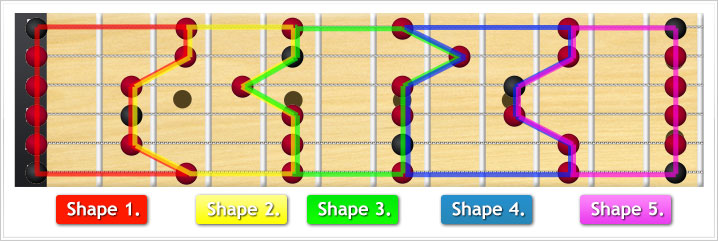
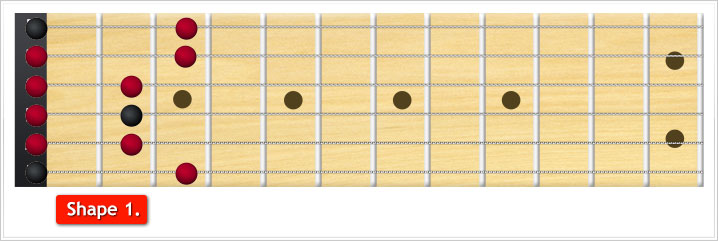
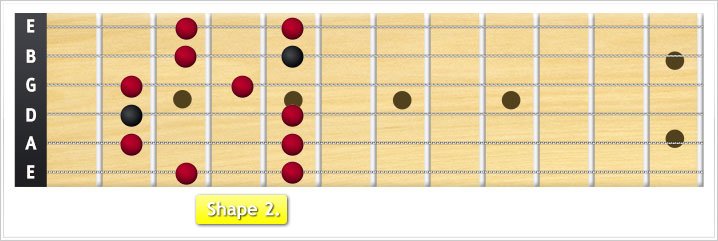
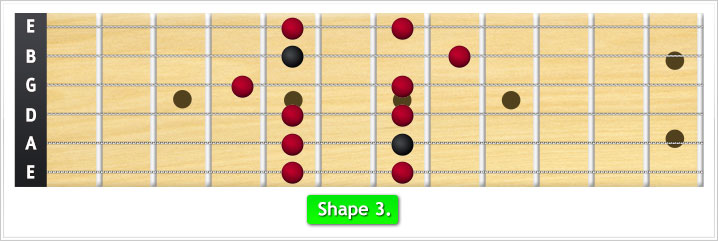
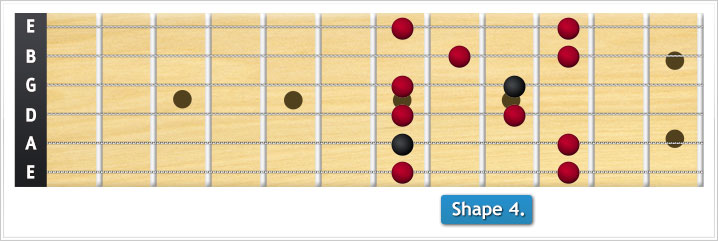
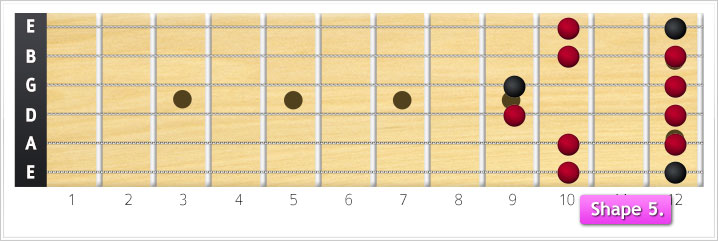
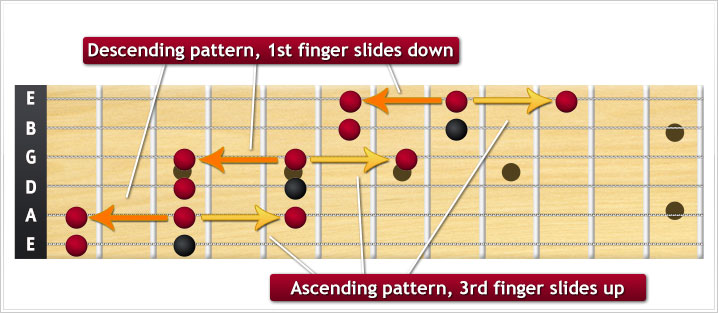





Thank you for posting this information and scales for each of the Pentatonic Scales, Notes and very helpful shape series of images. No one else makes it this straight forward, you are very thoughtful and helpful. Very Respectfully, Joaquin Guerrero Jr, “Jay”
Thank you! I found it so easy to navigate this info, it’s super helpful! I was really intimidated by the idea of learning the pentatonic shapes but now I feel really comfortable with them.
The info passed on this webpage is great. Thank you!